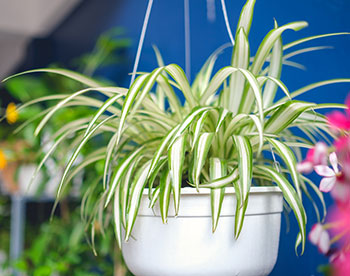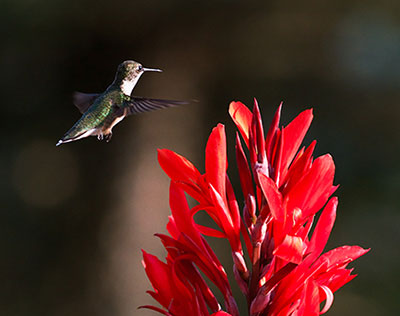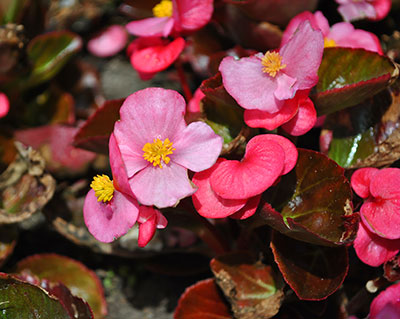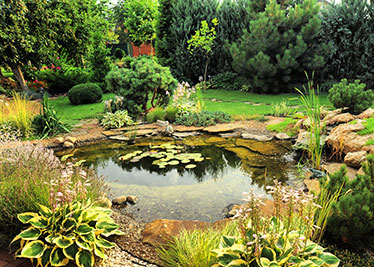Spring Landscaping
Spring Garden Maintenance

If your moving houseplants outdoors, keep them out of full-sun until they are fully
acclimated. Some houseplants cannot tolerate full sun at all.
Fast Facts
- Cover plants at night if frost returns.
- Have soil tested before your lawn greens up. We offer free soil testing.
- In May, begin fertilizing patio plants which overwintered indoors. A once a month
application with your favorite houseplant plant fertilizer will work. Make last application
in August.
- In June, begin to fertilize houseplants now that they are actively growing again.
Gardening Tips by Month
March
- Cautiously loosen winter mulches from perennials.
- Clean up beds by removing all weeds and dead foliage.
- Follow last soil test results for the type of fertilizer to use. If the soil was not tested, apply one pound of 10-10-10 fertilizer per 100 square
feet of area. Two cups of fertilizer equal one pound.
- Clean up last season’s growth of old plantings of perennials like peony, hollyhock
and phlox.
- If botrytis plagues your peony, begin spraying as soon as the foliage begins to emerge with
a recommended fungicide containing chlorothalonil. Follow label recommendations for rate and frequency of application.
- Dig, divide and share crowded fall-blooming perennials. Included are Shasta daisy, black-eyed susans, mums, day lilies, asters, garden phlox,
and hostas.
- Fertilize bulbs with a "bulb booster" formulation broadcast over the planting beds. If you did not have this site tested, apply 1 pound of 10-10-10 fertilizer per 100 square feet of area. Two cups of fertilizer equal one pound. Hose off any granules that stick to the foliage.
April
-
Fertilize established roses once new growth is 2 inches long. Use a balanced formulation. Begin spraying to control black spot disease.
- Deadhead or remove spent flowers from spring-blooming bulbs. Dig and divide spring bulbs which had smaller or fewer blooms. Wait until the foliage
starts to yellow or freely pulls loose when slightly tugged. Replant right away or
let the bulbs dry and plant in the fall.
- If spring flowering bulbs are in a marginal-to-poor soil and they did not bloom well,
they may benefit from an application of fertilizer. Fertilize spring blooming bulbs just after blooming. Use a
complete fertilizer such as 5-10-10 at a rate of 2 lbs. per 100 sq. ft.
- Stake perennials, clematis and other vines that fall over from their weight later in spring or summer.
This allows plenty of time for new growth to hide support structures.
- Prepare annual planting beds. Additives like well-rotted manure, processed manure, peat moss or compost are good for building compost humus in the soil.
May

Plant “natural nectar feeders” to provide more nectar for hummingbirds: cardinal flower,
cross vine, morning glory, bee balm, canna and four o’clock.
- Apply at least 2 to 3 inches of organic mulch to keep soils moist and cool. Do not pile the mulch directly around the base of perennials or against the bark
of trees or shrubs.
- Fertilize summer flowering shrubs/plants like crape myrtle and rose-of-Sharon.
- Do not forget to side-dress or fertilize your vegetables six to eight weeks after
germination.
- Remove spring bulb foliage as it turns yellow to brown. Dig and divide over crowded bulb plantings; plant immediately or store them until
this fall.
- Try "deer-resistant" annuals such as ageratum, snapdragon, wax begonia, cleome, dahlia, foxglove, blanket flower, and lobelia. Resistant perennials include yarrow, anemone, columbine, goat’s beard, astilbe, Shasta
daisy, coreopsis, bleeding heart, and coneflower.
- Check out our page on Deer Resistant Plants to find more plants that won't entice deer.
- Begin pinching the old tall chrysanthemum varieties and continue through early July.
- Stake tall-growing perennials such as foxglove and true lilies to prevent them from
falling.
- If peonies fail to flower, it could be they are planted too deep. Plant no more than 2 inches deep and they should receive at least 6 hours of sunlight
daily.
- As the days get hotter and pansies show stress, remove and replace with summer annuals.
June

Rhizomatous begonias are not just for shade. Many varieties, especially those with
bronze foliage, do well in full sun if given plenty of water and a well-drained site.
- Water plants in the morning to conserve water and reduce evaporation.
- Infrequent, deep-watering is better than frequent, shallow-watering, since deep-watering
promotes deep root growth. For best results, deep-water trees and shrubs once or twice a week and flowers two
to three times a
week. - Most plants need one inch of rainfall per week. Pay attention to how much falls from
the sky and water accordingly. If you have an automatic irrigation system, consider installing a rain sensor that
adjusts for rainfall.
- Renovate strawberry beds after harvest. Mow the rows; thin out excess plants; remove weeds; fertilize and apply a mulch for
weed control.
- Apply a balanced rose fertilizer after the first show of blooms is past
Water Garden

It's normal for water gardens to get a slight greening in the spring. Aquatic plants
are slow on waking up so you may get some excess nutrient build up which results in
greening. With a balanced ecosystem, you can expect this greening to last up to two
weeks.
April
- Clean ornamental pond or water feature and remove winter debris.
- Cutback and remove all dead plant debris from potted aquatic plants.
- Begin feeding fish slowly but by end of month they will be able to take daily feedings.